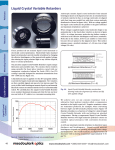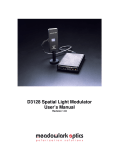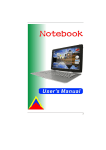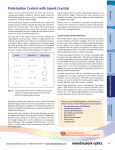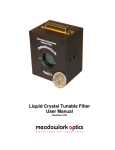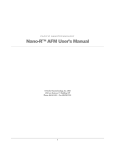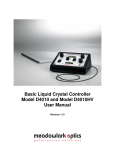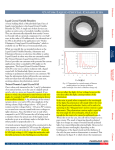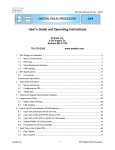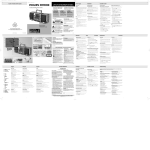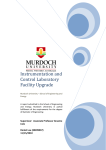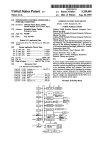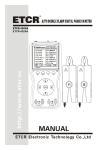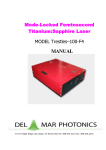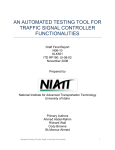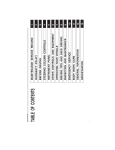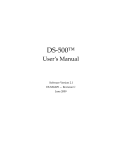Download Model D5020 - User Manual, Revision 1.01
Transcript
D5020 / D5020-20V Liquid Crystal Controller Manual Revision 1.01 Information in this document is subject to change without notice. Meadowlark Optics may have patents, patent applications, trademarks, copyrights, or other intellectual property rights covering subject matter in this document. Except as expressly provided in any written license agreement from Meadowlark Optics, the furnishing of this document does not give you any license to these patents, trademarks, copyrights, or other intellectual property. Please contact Meadowlark Optics for a list of applicable patents, trademarks, and/or copyrights. © 2014 Meadowlark Optics, Incorporated. All rights reserved. Printed in the United States of America Table of Contents Quick Start Guide .................................................................................. 3 1. Nematic Liquid Crystal Variable Retarder Basics ............................ 5 1.1 Physical architecture ......................................................... 5 1.2 Response time ................................................................... 7 2. Hardware Setup and Configuration ................................................... 8 2.1 Laboratory and system requirements ................................ 8 2.2 Using the digital interface controller ................................ 8 3. Computer Control ........................................................................... 10 3.1 CellDRIVE 5000 ............................................................ 10 3.1.1 Control Panel ................................................. 11 3.1.2 Waveform Control ......................................... 12 3.1.2.1 More on T.N.E. ............................ 12 3.1.3 Sync Pulse Controls ....................................... 15 3.1.4 External Input Controls. ................................ 15 3.1.5 Waveform Display ........................................ 15 3.1.6 Temperature Sensing and Control ................. 15 3.2 Additional Digital Interface Control Options ................. 17 3.2.2 Multistate Control Software .......................... 17 3.2.2 USB Control via C/C++ Program.................. 17 3.2.3 ASCII Commands and Conversions .............. 18 3.2.4 Custom LabVIEW VI Control....................... 20 4. Frequently Asked Questions ........................................................... 21 Appendix A: Firmware Updater ......................................................... 23 Appendix B: Software licensing ......................................................... 27 Software License Agreement ................................................. 27 Trademarks ............................................................................ 31 D5020 Digital Controller User Manual, rev. 1.01 1 Page intentionally left blank D5020 Digital Controller User Manual, rev. 1.01 2 Q Qu uiicckk SSttaarrtt G Gu uiiddee Requires a computer running Microsoft® Windows® XP or later. 1) Place the included CD in the CD-ROM drive, wait for the CellDRIVE menu to appear and click on the “Install CellDRIVE …” button. 2) The USB driver will need to be installed prior to connecting the controller to the computer. The CellDRIVE menu has an option to install the drivers. Otherwise, the driver installers are on the CellDRIVE CD in the following directories: 32 bit Windows® XP & newer: USB DRIVERS\32 bit\ 64 bit Windows® Vista & newer: USB DRIVERS\64 bit\ 3) Plug the USB cable into the appropriate connector on the digital interface controller. Plug the other end into an appropriate USB port on the computer. 4) Connect up to two Meadowlark Optics liquid crystal (LC) devices to appropriate connectors on the controller’s back panel. If a liquid crystal device has the temperature control (TSC) option installed, connect the temperature control cable to the appropriate five-pin LEMO™ connector. The D5020 controller is capable of independent TSC on both channels. 5) Plug the power supply into the appropriate connector on the controller back panel. Connect the power to a properly grounded outlet. Please note that the D5020 is capable of being USB powered; however, the temperature control circuitry will not function when the D5020 is being powered by the USB port on the PC. The D5020-20V is not capable of being USB powered. 6) Turn on the controller power. The LED in the switch will illuminate YELLOW initially, and then flash the firmware version in GREEN, followed by a steady GREEN. Please note that the previous D5020 settings are automatically used until changed by the user. 7) Start the CellDRIVE software by clicking Start All Programs Meadowlark Optics CellDRIVE 5000 CellDRIVE 5000. 8) Once the unit has been configured, it can be placed in autonomous mode, where it will output the configured waveforms even when disconnected from the computer. Please note that when using this mode, the external power supply must be used. Note: If the D5020 is powered off and then powered on, it will use the previously programmed configuration. D5020 Digital Controller User Manual, rev. 1.01 3 Figure 1 – Block diagram showing D5020’s connections and control options D5020 Digital Controller User Manual, rev. 1.01 4 1. Nematic Liquid Crystal Variable Retarder Basics 1.1 Physical architecture Typical nematic Liquid Crystal Variable Retarders (LCVRs) such as Meadowlark Optics’ LVR- and LRC- series are constructed using two optically flat fused silica windows coated with a transparent conductive coating. A thin dielectric layer is applied over this coating, which is the molecular alignment layer. The two windows are then assembled; creating a cavity that is filled with a birefringent nematic liquid crystal material. With no voltage applied, the liquid crystal molecules nominally lie parallel to the glass substrates and maximum retardation is achieved. Fused Silica ITO Alignment Layer a. Maximum Retardance (V=0) Spacer LC Molecules b. Minimum Retardance (V>>0) LC Molecules tipped with applied voltages Figure 2 – Liquid Crystal Variable Retarder showing molecular alignment (a) without and (b) with applied voltage (not to scale) When voltage is applied, liquid crystal molecules begin to tip perpendicular and as voltage increases, molecules tip further causing a reduction in the effective retardance. Molecules at the surface, however, are unable to rotate freely because they are pinned at the alignment layer causing a residual retardance, even at higher voltage. Meadowlark Optics can compensate for this residual retardance with a subtractive, fixed polymer retarder, called a compensator, which is attached to the liquid crystal cell. Figure 2 illustrates typical retardance as a function of D5020 Digital Controller User Manual, rev. 1.01 5 voltage for an LCVR with and without an attached compensator. We also have the ability to provide custom compensation to provide custom voltage operation. Uncompensated Compensated Figure 3 – Typical Liquid Crystal Variable Retarder performance versus voltage, with and without compensator 1.2 Response time For a standard nematic LC device switching response time depends on several parameters: layer thickness, viscosity, temperature, variations in drive voltage, surface treatment and the direction of the retardance change. Typical response time for a standard visible LCVR is shown in Figure 3. It takes about 5 ms to switch from one-half to zero waves (low to high voltage) and about 20 ms to switch from zero to one-half wave (high to low voltage). At temperatures greater than room ambient, LC material viscosity decreases, contributing to a faster response. D5020 Digital Controller User Manual, rev. 1.01 6 Response to normal square wave 90% 4 ms 22 ms 10% 0% t1 t2 t3 t4 Response to T.N.E. waveform 90% 10% 0% Figure 4 – Typical Transient response of standard LCVR Another control technique involves the Transient Nematic Effect (TNE) to improve response times. This technique uses a very short duration higher voltage spike to accelerate the molecular alignment parallel to the applied field. Voltage is then reduced to achieve the desired retardance. When switching from low to high retardance, all voltage is momentarily removed allowing the liquid crystal molecules to undergo natural relaxation. D5020 Digital Controller User Manual, rev. 1.01 7 2. Hardware Setup and Configuration 2.1 Laboratory and computer requirements One or Two voltage-controlled liquid crystal cells with SMA-to-SMB cables to connect the LC cells. Please note that LC cells are not included with the controller. 100-240 VAC, 47-63 Hz 500 mA power if using autonomous mode or temperature controlled LC cells. A computer with an available USB port. Minimum computer system requirements to run the included CellDRIVE 5000 software are 256 MB RAM, 250 MB hard drive space, 800x600 pixel, 16-bit color graphics display, a CD-ROM drive, and Microsoft® Windows® XP, Vista, Windows® 7 or Windows® 8. Figure 5 – D5020 Front and back panel connections. D5020-20V connections are identical, and the front panel is labeled D5020-20V. 2.2 Using the digital controller 1. Unpack controller and cables from shipping container. Please verify that your shipment included: Controller Controller to LCVR cable +12V power supply and power cord USB cable CellDRIVE software CD User’s manual D5020 Digital Controller User Manual, rev. 1.01 8 2. Install the CellDRIVE 5000 software and USB driver. Place the CellDRIVE 5000 CD in the CD-ROM drive. A menu should automatically load. If not, open the CD in Windows Explorer and double click on the “AutorunCD5K.EXE” file. Please note that this file’s icon is a picture of a CD. Click the “Install CellDRIVE 5000” button in the menu. Once CellDRIVE 5000 is installed, the menu will re-load. 3. The USB driver must be installed prior to connecting controller to the computer. The installers are located in the USB drivers directory of the CD, and can be installed via the Autorun menu. Please choose the 32 bit or 64 bit installer, as appropriate for your Windows ® version. Windows® XP, Vista, 7 and 8 are all available in either 32 bit or 64 bit versions. 4. Hardware configuration of the controller: If using the external power supply, connect the +12VDC supply to the controller. Plug the power supply into a properly grounded AC outlet. Please note that the external power supply is required for the D5020-20V. To use the USB interface, attach the USB cable to the USB connector on the rear of the controller and connect the other end to the USB port on the computer. Connect cables to attach up to two liquid crystal cells to the D5020 controller. If needed, connect the temperature sensing and control (TSC) cable to the five-pin LEMO® connector on the temperature-enabled controller channel. The controller is capable of TSC on either channel. 5. Turn on the front panel power switch and observe the LED in the switch. The LED will initially illuminate YELLOW. The LED will then blink the firmware version in GREEN and then remain illuminated GREEN as long as the controller is powered on and no error has occurred. If an error has occurred, the LED will flash RED. It will flash RED and return to GREEN when the controller receives a USB command. D5020 Digital Controller User Manual, rev. 1.01 9 6. 3. Computer Control There are several computer-based methods by which to control the amplitude of the 2-kHz square wave output signals. Therefore, signals and waveforms in this manual refer to an amplitude envelope about a 2-kHz square wave. For instance, a driver signal described as “invariant” actually refers to a square wave with a steady amplitude; the envelope is unchanging in time but the signal itself (if measured with an oscilloscope) oscillates about the zero-voltage axis. It is important to note that the square wave is always symmetric about the zerovoltage axis; thus “time-invariant” does not actually mean that a DC voltage is applied to a liquid crystal cell. As previously mentioned, zero-offset is critical for nematic liquid crystal cells. ! Voltage levels herein refer to the amplitude envelope of a 2-kHz square wave with near-zero DC offset. Applying any significant DC component to a liquid crystal cell may significantly decrease lifetime of the device. The most common methods of interfacing to the controller are: 1. Using CellDRIVE 5000 nematic liquid crystal driver software package from Meadowlark Optics (or using the external input capability). 2. Using a C/C++ program that communicates with the controller via USB 3. Developing a custom LabVIEW™ application using sub-VIs included on the CellDRIVE CD. 3.1 CellDRIVE 5000 CellDRIVE 5000 provides for internal and external waveform generation (amplitude modulation of the square wave) and temperature sensing and control for those LC devices equipped with our Temperature Sensing and Control (TSC) option. A closed-loop proportional feedback control circuit in the digital interface controller implements the temperature control feature with a user defined set point and measured temperature monitoring through the user interface. The TSC option uses active heating and passive cooling of the liquid crystal cell to achieve temperature stability within 1°C. The user interface, Figure 6, consists of a control section (left-hand side) and a waveform display section (right-hand side). Clicking the Meadowlark Optics logo at the top left of the user interface displays the software and firmware version numbers. D5020 Digital Controller User Manual, rev. 1.01 10 Figure 6 – CellDRIVE 5000 User Interface 3.1.1 Control Panel Along the top of the control section are buttons and indicators that operate as follows: Status Light: Above Controller menu button, illuminates as shown below (also see Port Test below): GREEN Port status OK when last checked YELLOW User-initiated port test underway RED Last user-initiated port test failed Controller n: Pull Down menu to select between multiple controllers connected to the same computer. Port Test: Initiates a read/write test of controller. The status light illuminates YELLOW during the test, then GREEN or RED upon completion. A GREEN light indicates proper communication between the controller and the computer and a RED light indicates a communication issue between the controller and computer. In the event of a RED light: 1. Check the cable connections. 2. Exit CellDRIVE, turn the controller off and back on, wait for the LED on the controller to stop flashing, then restart CellDRIVE. 3. Try a different USB cable. 4. Try running the unit with a different computer. 5. If all else fails, contact Meadowlark Optics for assistance. D5020 Digital Controller User Manual, rev. 1.01 11 Autonomous Mode Start: Quits CellDRIVE and displays information regarding the D5020 Controller’s autonomous mode, thus allowing the computer to be disconnected from the controller. The controller will continue executing the last set of parameters until reconnected to the computer and changed. Exit CellDRIVE: Quits CellDRIVE. The last voltages generated by CellDRIVE will remain on the controller outputs until the controller is powered off. The temperature will also be maintained until the controller is powered off. 3.1.2 Waveform Control In addition to the time-invariant setting, CellDRIVE 5000 provides the capability to select from and configure a variety of CellDRIVE generated waveforms for each individual output channel. Table 1 lists configuration parameters available with each waveform. Please note that the waveforms are synthesized within the controller to avoid any timing issues due to the computer, and the waveform display is a graphical representation of the waveform being generated by the controller. 3.1.2.1 More on T.N.E. The CellDRIVE 5000 user waveform display with T.N.E. mode configured on one channel (VTNE = 10V and TTNE = 150 msec) is shown in Figure 7. An example T.N.E. output envelope is shown in Figure 8; the 2-kHz square wave is shown within the envelope (the shaded region). By considering positive-voltage (top half) of the signal shown in Figure 8, one can distinguish a square wave varying between +3 and +7 volts. Immediately preceding the positive-going transition a 10-volt spike is observed. Similarly, immediately following the negative-going transition, a zero-volt spike is observed. The purpose of these spikes is to drive the state change in the liquid crystal faster than what would otherwise occur. When the T.N.E. waveform is selected, the user may specify the duration of the T.N.E. spike as well as the magnitude of the positive-transition spike (the negative-transition spike is always zero). D5020 Digital Controller User Manual, rev. 1.01 12 Figure 7 – CellDRIVE software display of T.N.E. waveform 10 5 0 -5 -10 Figure 8 – T.N.E. envelope D5020 Digital Controller User Manual, rev. 1.01 13 Waveform Table 1 – CellDRIVE 5000 waveform options Available Parameters Description and Ranges Off (None) Output is 0.0 V Invariant V1 0 – 10 V* Sinusoid V1 V2 T Φ 0 – 10 V* 0 – 10 V* 0.5 – ∞ sec -360° – 360° Triangle V1 V2 T Φ 0 – 10 V* 0 – 10 V* 0.5 – ∞ sec -360° – 360° Square V1 V2 T Φ % Duty Cycle 0 – 10 V* 0 – 10 V* 0.5 – ∞ sec -360° – 360° 0 – 100 % Sawtooth V1 V2 T Φ 0 – 10 V* 0 – 10 V* 0.5 – ∞ sec -360° – 360° Threshold V1 V2 0 – 10 V* 0 – 10 V* Output is time-invariant square wave with user-specified amplitude. Output is a square wave within an envelope that varies sinusoidally between V1 and V2 over user-specified period. The Phase relative to the other output channel can also be varied. Output is a square wave within an envelope that varies linearly from V1 to V2 and back to V1 over a user-specified period. The phase relative to the other output channel can also be varied. Output is a square wave within an envelope varying instantly between V1 and V2 over user-specified period. Phase relative to other output channel and duty cycle (ratio of positive-voltage duration to total period, expressed as percent) can also be varied. Output is a square wave within an envelope rising linearly to V1 or V2 (whichever is greater) over user-specified period, and then dropping instantly to the lower voltage. The phase relative to the other output channel can also be varied. The I/O connector is monitored, and if less than 2.5V, output = V1. Otherwise, output is V2. V1 V2 T Φ 0 – 10 V* 0 – 10 V* 0.5 – ∞ sec -360° – 360° 0 – 100 % 0 – 10 V* 0 – 255 ms Transient Nematic Effect. Identical in behavior to square wave with the following exception: a voltage spike occurs for a brief interval immediately following a positive transition, and similarly the voltage drops to zero for a brief interval immediately following a negative transition. T.N.E. % Duty Cycle VTNE TTNE The I/O connector is monitored for pulses. When a pulse is received, if the output is at Trigger V1, it switches to V2. If the output is at V2, it switches to V1. *- If the unit has the 20V option, the maximum voltage becomes 20V. V1 V2 0 – 10 V* 0 – 10 V* D5020 Digital Controller User Manual, rev. 1.01 14 3.1.3 Sync Pulse Controls CellDRIVE 5000 provides the capability to output a TTL sync pulse (high for approximately the selected period) on the front panel I/O connector at specified points in the CellDRIVE generated waveform. This sync pulse may be used for purposes such as triggering external lab equipment at specific times. The sync output and external input may not be used for the same channel at the same time, as both utilize the same connector. Sync Out: Toggles sync pulse generation on and off for the specified channel. A visual indicator of sync pulse generation is shown as a brief spike on the graph of the generated waveform whenever a sync pulse is output (this will appear as a pulse in the waveform charts). Sync pulse generation may be enabled for any combination of channels. It is up to the user to determine which sync pulses are associated with which channel. [NOTE: The sync pulse is not an actual voltage spike being sent to the LC device.] Sync Out Phase: Specifies at which point in the waveform the sync pulse is generated, and is additive to any phase specified in the respective waveform control. Sync Out Duration: Specifies approximate duration for the output sync pulse. 3.1.4 External Input Controls CellDRIVE 5000 provides the capability to drive the channel outputs via an externally generated signal applied to the front panel I/O connector. The input DC signal must be between 0V (corresponds to a square wave of 0V amplitude on the output channel) and 5V (corresponds to a square wave varying between –10V and +10V amplitude* on the output channel). As an example using a standard D5020, if the user desires a sinusoid on the output channel that varies between 0 Vp-p and 8 Vp-p then the externally applied signal must be a sinusoid that varies between 0 V and +4 V amplitude. The external input and sync output may not be used for the same channel at the same time, as both utilize the same connector. External Input: Applying a signal to the front panel I/O connector for the appropriate channel and selecting the external input button in the user interface for that channel configures the controller to periodically sample the signal voltage, generate the appropriate amplitude square wave and output it to the selected channel. Sync out and waveform controls will be disabled for each channel that has external inputs active (generation of sync out pulses is not possible if using external inputs). Any channel that has not been selected may be controlled normally through the software, including generation of sync pulses. *-If the unit has the 20V option, this voltage range becomes -20V to +20V. D5020 Digital Controller User Manual, rev. 1.01 15 3.1.5 Waveform display The right-hand side of the user interface consists of waveform display options, which include the row of tabs along the bottom of the display section. The tabs provide choices for numeric or graphic display modes and the usercontrolled display options are: Numeric: Shows the instantaneous voltage for each channel, and status lights indicating updated voltages on each channel. 1 Plot / 2 Plots: Selects number of channels to plot on the waveform display graph. For instance, if only one channel is being used, one might select “1 Plot”. If one channel is driven by time-invariant values while the second is driven in T.N.E. mode, one might choose to plot only the T.N.E. channel. The choice of display has no effect on output to the LC channel - choosing to display channel 2 does not affect the signal output of channel 1. Legend: The waveform plotted on a particular graph is selected by clicking left of the number on the plot legend. Clicking right of the number on the plot legend gives a menu of options for displaying a plot. Y: This button auto scales the vertical axis or axes to a range of 0-10 V (or 0-20V if using a unit with the 20V option.) X: This button auto-scales the horizontal axis to show the most recent 5000 values for voltage, or to all of the voltage values if less than 5000 have been acquired. Zoom/Pan: Includes a variety of zoom and pan features for viewing the graph. Horizontal Scroll bar: Enables scrolling back to review 5000 most recent voltage values. Vertical Axis Values: These may be double-clicked and “edited” to change the vertical axis range. 3.1.6 Temperature Sensing and Control (TSC) The temperature control interface includes the following: Set Temp: Allows user to set the temperature (°C) at which a temperature-controlled (TSC option) LC is to be maintained. Temp Update: Flashes when temperature measurement displayed on the screen is updated. Current Temp: Displays present temperature of a temperaturecontrolled LC. If temperature is within 1 degree of the set point the number will be in GREEN text, otherwise it will be RED. D5020 Digital Controller User Manual, rev. 1.01 16 3.2 Additional Digital Interface Control Options There are other digital interface control options: multistate control software, a user created program to communicate with the controller via USB, or by using custom LabVIEW VIs supplied by Meadowlark Optics. Table 2 details a complete list of ASCII firmware commands that may be used when performing USB or HyperTerminal control. Note that all commands are lower case. 3.2.1 Multistate Control Software There is software available for the D5020 that allows preconfiguration of up to 16 voltage states for LC control. The D5020 is capable of switching states randomly, in a fixed pattern, or when receiving a pulse at the I/O 1 connector. When changing state randomly or in a fixed pattern, the time the LC remains each state is set independently. With this software, the state is switched for both LCs at the same time. Please contact Meadowlark Optics at [email protected] for details. 3.2.2 USB Control via C/C++ Program The user can write a program that communicates directly with the controller through a USB connection. Included on the CellDRIVE CD (Source Code folder) is a source code file (usb_ver.cpp) that initializes a USB connection to the controller, sends a ver:? command and reads the status response (after sending any command, status must be read before another command can be sent). This program may be used as a starting point and modified as necessary to perform the desired task(s). Header file usbdrvd.h must be included in the source code and either the library file usbdrvd.dll or usbdrvd.lib (all included on the CellDRIVE CD) must be linked in the final program. The sample code uses usbdrvd.dll; however some compilers will require the usbdrvd.lib file. If a user developed or modified application program is to be distributed in any way, please contact Meadowlark Optics for licensing and copyright details. 3.2.3 ASCII Commands and Conversions The D5020’s available ASCII commands are summarized in Table 2. Please see notes regarding number conversion as well as compatibility below. To convert the 16-bit integer values for temperature in Table 2, use the following conversion formulae: Convert from Set-point (t) to temperature (T) (°C): T = (t*500/65535) – 273.15 Convert to Set-point from temperature (°C ): t = (T +273.15) * 65535/500 The D5020 will accept the ld, ldd, ldx and tne commands from the D3040 and D3050 controllers for compatibility reasons. See table 3 for a summary of these commands. These commands are not recommended for use, as the voltages set by them will not be retained by the D5020 when it is powered off and back on. The D5020 will instead return to the last state set using the commands shown in table 2. To ensure expected operation and consistent power-on state of the D5020, please use the commands shown in table 2. D5020 Digital Controller User Manual, rev. 1.01 17 Table 2 – ASCII commands for the Digital Interface Controller Firmware Command inv:n,v1 sin:n,v1,v2,t,ph<CR> saw:n,v1,v2,t,ph<CR> tri:n,v1,v2,t,ph<CR> Description Sets up the specified channel to output an invariant voltage v1. Sets up the specified channel to output a sine wave varying between v1 and v2, with period t and phase ph. Sets up the specified channel to output a sawtooth wave varying between v1 and v2, with period t and phase ph. Sets up the specified channel to output a triangle wave varying between v1 and v2, with period t and phase ph. sqr:n,v1,v2,t,ph,dc<CR> Sets up the specified channel to output a square wave varying between v1 and v2, with period t, phase ph, and duty cycle dc. tnew:n,v1,v2,t,ph,dc,tv,tt <CR> Sets up the specified channel to output a square wave varying between v1 and v2, with period t, phase ph, duty cycle dc, with pulses to TNE voltage tv, and of duration TNE time tt. sync:n,ph,t<CR> extin:n<CR> thr:n,v1,v2<CR> tmp:n,?<CR> trg:n,?<CR> tsp:n,t<CR> tsp:n,?<CR> ver:?<CR> Produces sync pulse (high-low) on front panel I/O connector specified by n, with phase ph, and time t. Enables output channels to be driven by signal applied to front panel I/O connector. I/O connector n is monitored, and if less than 2.5V, output = V1. Otherwise, output is V2. Query current temperature of temperature controlled LC on channel n. I/O connector n is monitored for pulses. When a pulse is received, if the output is at V1, it switches to V2. If the output is at V2, it switches to V1. Sets temperature setpoint for temperature control for channel n Query current temperature setpoint for channel n. Query firmware version. *- If the unit has the 20V option, the voltage becomes 20000mV. D5020 Digital Controller User Manual, rev. 1.01 18 Notes n = LC channel (1,2) v1 = 0-10000 (millivolts)* n = LC channel (1,2) v1,v2 = 0-10000 (millivolts)* t = 5-65535 milliseconds ph = 0-360 (degrees) n = LC channel (1,2) v1,v2 = 0-10000 (millivolts)* t = 5-65535 milliseconds ph = 0-360 (degrees) n = LC channel (1,2) v1,v2 = 0-10000 (millivolts)* t = 5-65535 milliseconds ph = 0-360 (degrees) n = LC channel (1,2) v1,v2 = 0-10000 (millivolts)* t = 5-65535 milliseconds ph = 0-360 (degrees) dc = 0-100 (percent) n = LC channel (1,2) v1,v2 = 0-10000 (millivolts)* t = 5-65535 milliseconds ph = 0-360 (degrees) dc = 0-100 (percent) tv = 0-10000 (millivolts) tt = 0-255 (milliseconds) n =channel (1,2) ph = phase relative to waveform (degrees) t = pulse length (microseconds) n =channel (1,2) n = channel (1,2) v1,v2 = 0-10000 (millivolts)* Controller returns 16-bit integer i converted to temperature by T (ºC) = (i*500/65535) - 273.15 n = channel (1,2) v1,v2 = 0-10000 (millivolts)* n = channel (1,2) t is 16-bit integer Controller returns 16-bit integer (t) Controller returns firmware version and copyright string Table 3 – Legacy ASCII commands for the D5020 Controller and conversions from D3050 code. Firmware Conversion required Description Notes Command from D3050 code ld:n,v<CR> Sets up the specified channel to output voltage v. n = LC channel (1,2) v = 0-10000 (millivolts)* Take voltages in counts and divide by 6.5535. If an ldd or ld command was not sent prior to querying If needed, convert the controller, the output of voltages to count by ld:n,? <CR> this command will be multiplying by 6.5535. undefined. Take voltages in counts Sets channel 1’s output to ldd:v1,v2 v1,v2 = 0-10000 and divide by 6.5535. v1 and channel 2’s output (millivolts)* Only two channels <CR> to v2. available. If an ldd or ld command was If needed, convert not sent prior to querying voltages to counts by Query the voltage on both the controller, the output of multiplying by 6.5535. ldd:? <CR> channels. this command will be Only two channels are undefined. available. Convert to decimal, Works the same as ldd, i1,i2 = 0x0000 – 0xFFFF divide result by 6.5535 but i1 and i2 are the ldx:i1i2<CR> (hexadecimal)* and convert to voltages in hexadecimal. hexadecimal. Sets up the specified n = LC channel (1,2) channel to perform TNE t = 0-255 (milliseconds) Take voltages in counts v = 0-10000 (millivolts)* tne:n,t.v<CR> switching with a TNE and divide by 6.5535. pulse of duration t at Useful only with ld, ldd and voltage v. ldx commands. Query the TNE If needed, convert tne:n,? configuration for the n = LC channel (1,2) voltages to counts by specified channel. multiplying by 6.5535 * - If the unit has the 20V option, the voltage becomes 20000 mV (The range stays 0x0 – 0xFFFF for hexadecimal, though.) Query the voltage setting on the specified channel. 3.2.4 Synchronizing two D5020 units If control of four LCs is needed, two D5020s may be synchronized. This is done by first setting up one unit (the master) to output a square wave on both channels. Then, sync out should be configured for either one or both channels. If only one channel is used, a tee will be needed for connection to the second unit. Next, configure the second unit (the slave) to use the triggered waveform for both channels. Finally, connect cables from the I/O connectors on the master to the I/O connectors on the slave. The two units will then have synchronized switching to within 500 uS. D5020 Digital Controller User Manual, rev. 1.01 19 3.2.5 Custom LabVIEW VI Control An example VI and a LabVIEW library file are included on the CellDRIVE 5000 CD in the LabVIEW folder. These include: Meadowlark USB IO Example.VI Meadowlark USB.LLB o o o o o o o o o Meadowlark USB Com.VI – Performs USB Communication Meadowlark USB Easy Close.VI – Closes USB connection to controller Meadowlark USB Easy Open.VI – Opens USB connection to controller Meadowlark USB Get Command.VI – Helper VI Meadowlark USB Read Config.VI – Reads D5020’s current configuration Meadowlark USB Read Temp Setpoints.VI – Reads the D5020’s current temperature setpoints for temperature controlled LC devices. Meadowlark USB Read Temperature.VI – Reads the temperature of connected temperature controlled LC cells. Meadowlark USB Set Temperature Setpoint.VI – Sets the temperature control setpoints for temperature controlled LC devices. Meadowlark USB Set Waveform.VI – Sets a waveform output from the D5020. The sample VIs include a LabVIEW library file containing fundamental VIs and an example that implements them in a program which sets and reads controller voltages. The LabVIEW back panel of the IO Example VI is user accessible to facilitate independent development. Programmers are encouraged to open and examine the IO Example diagram screen. Please note that the LabVIEW development suite, version 2010 or newer, from National Instruments is required to use the included VIs, and is not provided with any version of CellDRIVE software. It is assumed that the customer has experience programming in LabVIEW and understands good programming practices. Meadowlark Optics cannot offer customer support for LabVIEW application development. If a developed or modified LabVIEW application is to be distributed in any way, please contact Meadowlark Optics for licensing and copyright details. D5020 Digital Controller User Manual, rev. 1.01 20 4. Frequently Asked Questions Q: The controller is not working. A: Check the power supply is plugged in, front panel switch is on and the green power light is steady. If using a USB interface, check the status of the controller under Windows® Device Manager by looking for a Meadowlark Optics D5020. Occasionally it helps to turn off the controller, wait a few seconds, and then turn it back on. Q: I started the CellDRIVE software and then turned on the controller, and now the software is behaving erratically. What is happening? A: The controller must be turned on and have completed its power-on self-test before starting the CellDRIVE software. Q: Liquid crystal cells are not changing state. A: Check SMA connections and measure LC cell end of the cable with an AC (true-RMS) voltmeter or oscilloscope. An oscilloscope will show a 2-kHz square wave with an amplitude set by the last waveform sent to the controller. ALTERNATELY: Double check the optical alignment of the cell. Some cell orientations won’t affect polarization if they happen to align with an Eigen axis (fast or slow axis of the liquid crystal retarder). Q: I can’t use the SMA connectors on the back of the device, I need BNC. A: BNC jack to SMA plug adapters are available from Meadowlark Optics. Meadowlark Optics can also provide (SMA to SMB) custom cable adapters to attach Meadowlark Optics LC cells. Q: I need a particular waveform generated. A: Develop code using LabVIEW™ development suite and VIs included on the CellDRIVE CD. We can also custom-program any waveform into CellDRIVE 5000; please contact us for details. ALTERNATIVELY: Use a signal generator with the external input capability of CellDRIVE 5000. Q: How do I uninstall the CellDRIVE software? A: Use the Add/Remove Programs option in the Windows® control panel. Q: Can I use multiple controllers to control more than two LC cells? A: Yes. The CellDRIVE 5000 program is designed to handle up to four controllers connected to USB ports, giving a total of 8 channels of control. Waveform selection and temperature monitoring is limited to two channels (one controller) at a time. However, the controller will continue to generate the last selected waveform even if it is not currently being monitored. D5020 Digital Controller User Manual, rev. 1.01 21 Q: In TNE mode, the graphical display shows that TNE spikes are sometimes missing from the waveform. A: Extremely short TNE spikes are occasionally misrepresented on the CellDRIVE 5000 interface, but viewing the controller’s output with an oscilloscope will verify that they are consistently produced and delivered to the LC cell. Q: What are the power-on default voltage and temperature values? A: The controller will remember its previous settings. Q: The LED on the controller is currently blinking RED. A: There has been an internal error. Try turning the controller off and back on. If the controller does not return to normal operation, contact Meadowlark Optics for assistance. D5020 Digital Controller User Manual, rev. 1.01 22 Appendix A: Firmware Updater The user can reprogram the internal firmware when new versions are released. Update is accomplished by using the firmware updater program included on the CellDRIVE CD. In order to use the firmware updater program the controller must be powered on and connected to an available USB port on the host computer. Perform the following steps to reprogram the controller firmware: ® 1. Install firmware updater software on a computer running Microsoft ® Windows (XP or later). Place CellDRIVE CD in the CD-ROM drive, wait for the CD menu to appear and click on the “Install Firmware Updater” button. 2. Start the firmware updater software by clicking StartProgramsMeadowlark OpticsFirmware updater. The following screen will appear: 3. Cycle power on the controller to ensure the USB connection is properly made. Wait until the front panel status LED is done flashing before clicking OK. If the power is not cycled or the OK button is clicked before the front panel status LED is done flashing, the following error will be displayed. If this error appears, close the firmware updater program and re-run it. D5020 Digital Controller User Manual, rev. 1.01 23 4. The following screen will appear after the USB connection is made. 5. Choose the new hex file and click “OK”. The program will check if the new firmware file is valid for the controller, if not, the following error screen will appear. At this point the user may elect to choose a different file or go ahead and program the controller with the chosen file. Extreme caution should be exercised when deciding whether to program the controller with a file that may not be compatible. If there are questions about choosing the appropriate file, please contact Meadowlark Optics at 303-833-4333. D5020 Digital Controller User Manual, rev. 1.01 24 6. After the hex file is loaded and passes validity tests, the ready screen appears. Click the Program button to reprogram the controller firmware. If a final check is desired before reprogramming the firmware, the Meadowlark Optics logo may be clicked to display a screen showing the old and new firmware versions. 7. As the firmware is being erased and reprogrammed the status will be displayed as shown. DO NOT disturb power to the controller while it is erasing or reprogramming. If power is disturbed the controller’s memory will be corrupted, requiring the unit to be returned to Meadowlark Optics for reprogramming. D5020 Digital Controller User Manual, rev. 1.01 25 8. After programming is complete, the following screen appears. When the controller power is cycled, the status light should flash a pattern corresponding to the version number of the new firmware. The new firmware version may also be determined by clicking the Meadowlark Optics logo in the upper left corner of CellDRIVE. D5020 Digital Controller User Manual, rev. 1.01 26 Appendix B: Software Licensing IMPORTANT. CAREFULLY READ THE TERMS AND CONDITIONS OF THIS LICENSE AGREEMENT BEFORE USING THIS SOFTWARE. This Meadowlark Optics, Inc. License Agreement is a legal agreement between you (“Licensee”) and Meadowlark Optics, Inc. (“Licensor”) for the enclosed computer software, and any associated media, printed materials and online or electronic documentation (“Software”). By installing or otherwise using the Software Product, you agree to be bound by the terms of this License Agreement. If you do not agree to the terms of this License Agreement, do not use or install the Software Product, you may however return it to your place of purchase for a refund. SOFTWARE LICENSE AGREEMENT This Software License Agreement (“Agreement”) is entered into between Meadowlark Optics, Inc (“Licensor”) and you as Licensee, (Licensee”). 1. Definitions a. Software. The term “Software” shall mean the enclosed computer software, and any associated media, printed materials and online or electronic documentation. The term “Software” includes any corrections, bugs, fixes, enhancements, updates or other modifications, including custom modifications, to such computer programs. 2. License a. Grant of License. Licensor grants Licensee, pursuant to the terms and conditions of this Agreement, a limited, revocable, nonexclusive, non-transferable license to use the Software, which has been built with National Instruments LabVIEW™ Application Builder. b. Restrictions on Use. Licensee agrees to use the Software only for Licensee’s own business. Licensee shall not: (i) permit any parent, subsidiaries, affiliated entities or third parties to use the Software; (ii) process or permit to be processed the data of any other party, (iii) use the Software in the operation of a service bureau, or (iv) allow access to the Software through any terminals located outside of Licensee’s Site. c. Copies. Licensee, solely to enable it to use the Software, may make one archival copy of the Software computer program, provided that the copy shall include Licensor’s copyright and any D5020 Digital Controller User Manual, rev. 1.01 27 other propriety notices. The Software delivered by Licensor to Licensee and the archival copy shall be stored at Licensee’s Site. 3. d. Modifications, Reverse Engineering. Licensee agrees that only Licensor shall have the right to alter, maintain, enhance or otherwise modify the Software. Licensee shall not disassemble, decompile or reverse engineer the Software. e. Material Terms and Conditions. Licensee specifically agrees that the terms and Conditions of this Section 2 are material and that failure of Licensee to comply with these terms and conditions shall constitute sufficient cause to terminate this Agreement. Data Conversion, Support a. Data Conversion. Licensee shall be solely responsible for data conversion, data entry and verification of data. b. 4. Ownership a. Title. Licensee and Licensor agree that Licensor owns all proprietary rights, including patent, copyright, trade secret, trademark and other proprietary rights, in and to the Software and any bug fixes, enhancements, updates or other modifications, including custom modifications, to the Software, whether made by Licensor or any third party. b. 5. Support. Licensor may provide Licensee with support services related to the Software. Use of Support services is governed by the Licensor policies and programs described in the Service Level Agreement. Any supplemental software code, modifications or enhancements provided to you as part of the Support service shall be considered part of the Software and subject to the terms of this License Agreement. Transfers. Under no circumstances shall Licensee sell, license, publish display, distribute or otherwise transfer to a third party the Software or any copy thereof, in whole or in part, without Licensor’s prior written consent. Limited Warranty; Support Services a. Scope of Warranty. Licensor warrants for a period of one year from the date of receipt of the Software against faulty workmanship or the use of defective materials and that such Software will conform to Licensor’s accompanying written specifications. This limited warranty shall be void in the event of failure from accident, abuse or misapplication. D5020 Digital Controller User Manual, rev. 1.01 28 b. Disclaimer of Any Other Warranty. THE LIMITED WARRANTY SET FORTH IN SUBSECTION 5.a IS IN LIEU OF ALL OTHER WARRANTIES, INCLUDING, BUT NOT LIMITED TO, THE IMPLIED WARRANTIES OF MERCHANTABILITY AND FITNESS FOR A PARTICULAR PURPOSE. 6. No Consequential Damages NEITHER PARTY SHALL BE LIABLE TO THE OTHER FOR INDIRECT, SPECIAL, INCIDENTAL, EXEMPLARY OR CONSEQUENTIAL DAMAGES (INCLUDING, WITHOUT LIMITATION, LOST PROFITS) RELATED TO THIS AGREEMENT OR RESULTING FROM LICENSEE’S USE OR INABILITY TO USE THE SOFTWARE, ARISING FROM ANY CAUSE OF ACTION WHATSOEVER, INCLUDING CONTRACT, WARRANTY, STRICT LIABILITY OR NEGLIGENCE, EVEN IF THAT PARTY HAS BEEN ADVISED OF THE POSSIBILITY OF SUCH DAMAGES. 7. Limitation on Recovery Under no circumstances shall the liability of Licensor to Licensee exceed the amounts paid by Licensee to Licensor under this Agreement. 8. Indemnity Licensor shall indemnify and hold harmless Licensee from and against any claims based on infringement of any United States copyright or patent by the Software. Licensee agrees to cooperate fully with Licensor during such proceedings. Licensor shall defend and settle at its sole expense all proceedings arising out of the foregoing. In the event of such infringement, Licensor may replace, in whole or in part, the Software with a substantially equivalent computer program or modify the Software to avoid the infringement. 9. Term and Termination a. Term. This license agreement is effective from the date of receipt of this agreement and shall remain in full force until terminated. Without prejudice to any other right, Licensor may terminate this agreement if you fail to comply with any of the terms and conditions of this license agreement. b. Procedure upon Termination. Within ten (10) days after termination of this Agreement, Licensee will return to Licensor, at Licensee’s expense, the Software and all copies thereof, delete or destroy all other copies of the Software, and deliver to Licensor a D5020 Digital Controller User Manual, rev. 1.01 29 certification, signed by an officer of Licensee, that the Software has been returned, all copies deleted or destroyed, and its use discontinued. 10. Force Majeure If performance hereunder (other than payment) is interfered with by any condition beyond a party’s reasonable control, including any Act of God, the affected party shall be excused from such performance to the extent of such condition. However, if a force majeure detrimentally affects a party’s performance of a material obligation hereunder for 14 days or more, the other party can terminate this Agreement. 11. Mediation, Arbitration The parties shall endeavor to resolve any dispute by mediation in Boulder, CO under the CPR Mediation Procedure. If the parties have not resolved this matter within 45 days from the selection of a mediator, the parties shall settle any controversy arising out of this Agreement) by arbitration to be held in Boulder, Colorado, in accordance with the rules of the American Arbitration Association. A single arbitrator shall be agree upon by the parties, or, if the parties cannot agree upon an arbitrator within thirty (30) days, then the parties agree that a single arbitrator shall be appointed by the American Arbitration Association. The arbitrator will apply the substantive law of the State of Colorado. The arbitrator may award attorney’s fees and costs as part of the award. The award of the arbitrator shall be binding and may be entered as a judgment in any court of competent jurisdiction. 12. Notices Any notice under this Agreement will be in writing and delivered by personal delivery, overnight courier, confirmed facsimile, confirmed email, or certified or registered mail, return receipt requested, and will be deemed given upon personal delivery, 1 day after deposit with an overnight courier, 5 days after deposit in the mail, or upon confirmation of receipt of facsimile or email. Notices will be sent to a party at its address set forth at the end of this Agreement, or such other address as a party may specify in writing pursuant to this Section. 13. Entire Agreement; Amendment; Waiver This Agreement sets forth the entire understanding and agreement of the parties, and supersedes any and all oral or written agreements or understandings between the parties, as to the subject matter of the Agreement. This Agreement may be changed only by a writing signed by both parties. The waiver of a breach of any provision of this D5020 Digital Controller User Manual, rev. 1.01 30 Agreement will not operate or be interpreted as a waiver of any other or subsequent breach. 14. Severability; Headings If any provision herein is held to be invalid or unenforceable for any reason, the remaining provisions will continue in full force without being impaired or invalidated in any way. The parties agree to replace any invalid provision with a valid provision that most closely approximates the intent and economic effect of the invalid provision. Headings are for reference purposes only and in no way define, limit, construe or describe the scope or extent of such section. 15. Governing Law This Agreement will be governed and construed in accordance with the laws of the State of Colorado without giving effect to conflict of laws principles. Both parties submit to personal jurisdiction in Colorado. Trademarks National Instruments, LabVIEW, and NI-VISA are trademarks of National Instruments Corporation. Microsoft®, Windows®, and MS-DOS ® are registered trademarks of Microsoft Corporation. Pentium® is a registered trademark of Intel Corporation. LEMO™ is a registered trademark of LEMO-USA D5020 Digital Controller User Manual, rev. 1.01 31 Page intentionally left blank 5964 Iris Parkway P.O. Box 1000 (US Mail) Frederick, Colorado 80530 303-833-4333 [email protected] www.meadowlark.com




































